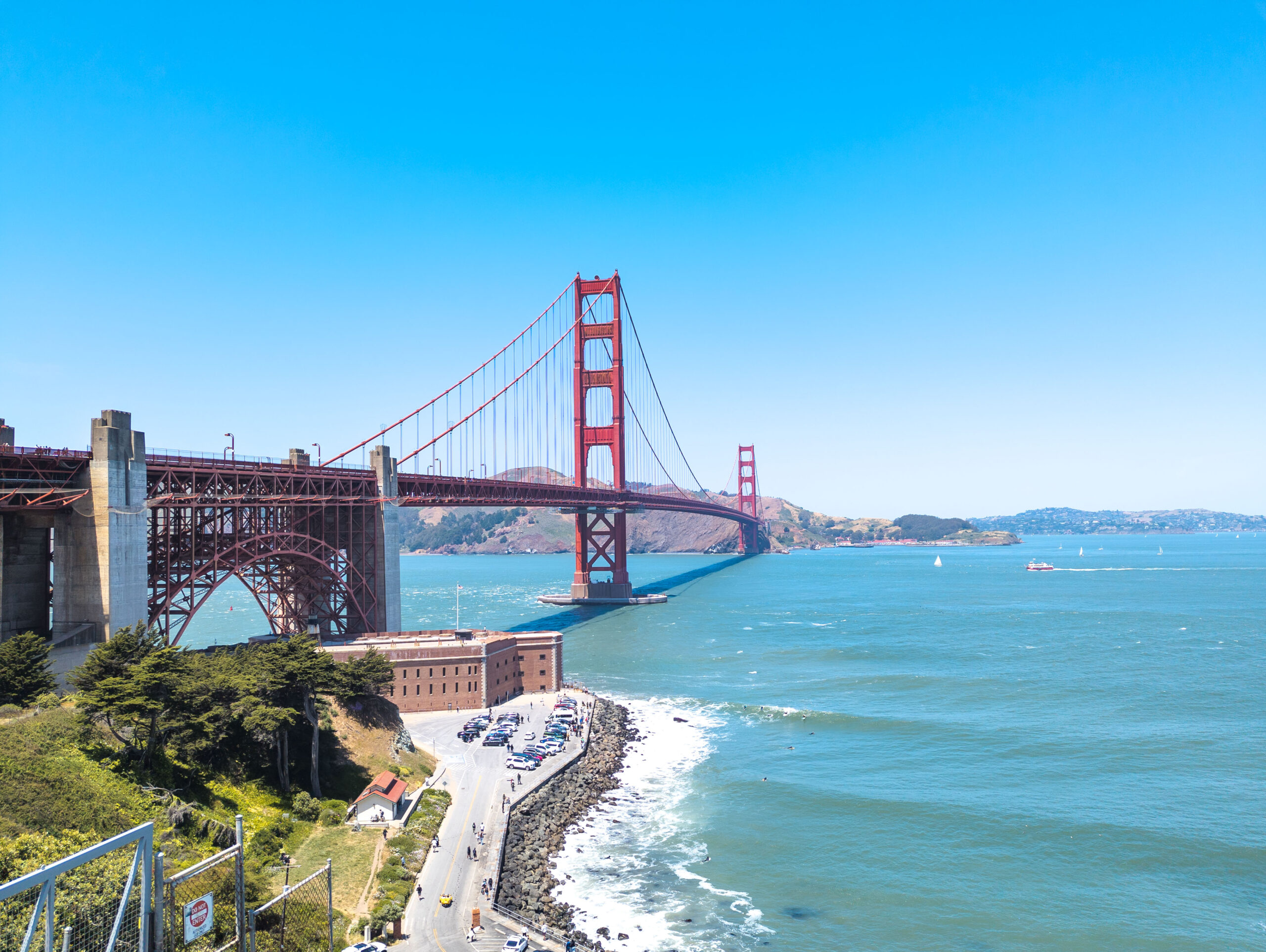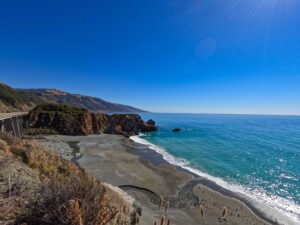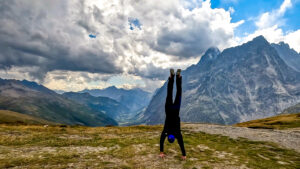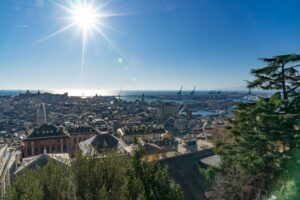Overview: This initial installment of the West Coast road trip details a multi-day exploration of San Francisco and its surrounding Bay Area. The journey begins with the drive north from Southern California, marked by an unexpected roadside fire and strategic outlet shopping, before delving into the heart of Silicon Valley. In San Francisco itself, experiences range from navigating the city’s public transport and staying in a budget-friendly hostel to confronting urban realities and marveling at world-renowned landmarks. Highlights include a visit to the infamous Alcatraz Island, walking the majestic Golden Gate Bridge, exploring Golden Gate Park, riding historic cable cars, and culminating with breathtaking panoramic views from Mount Tamalpais. This post aims to provide a comprehensive guide to these experiences, enriched with historical context, practical tips, and cultural insights.
Day 1: Saturday – The Northward Migration: Fire, Bargains, and Silicon Dreams
- Route: Valencia (North of Los Angeles) to Millbrae (San Francisco Bay Area), via I-5 N, I-580 W, and various Silicon Valley thoroughfares.
- Key Stops/Activities: Witnessing a grass fire near I-5, San Francisco Premium Outlets (Livermore), scenic drive through Silicon Valley (NXP Semiconductors, onsemi, Marvell Technology, Googleplex), parking at Millbrae BART/Caltrain station.
- Travel Tech: Utilizing Clipper card via Google Wallet on BART.
- Overnight: Hostel in downtown San Francisco (near Union Square).
The San Francisco adventure commenced around 8:00 AM from Valencia, CA, with the Southern California morning surprisingly cloaked in thick fog and light drizzle. The Google Maps estimate of just over five hours to the Bay Area proved optimistic, partly due to unplanned yet significant encounters.
An early, dramatic event unfolded along Interstate 5: a substantial grass fire raged alarmingly close to the highway, perhaps only 50 meters distant. Flames aggressively consumed large swathes of dry vegetation, sending thick smoke plumes into the otherwise clear sky – a stark, immediate reminder of California’s pervasive wildfire risk, especially during dry seasons. Approximately 15 minutes after passing the main blaze, firetrucks were observed rushing to the scene on the opposite carriageway.
The first planned stop was the San Francisco Premium Outlets in Livermore. For European visitors, US prices for brands like Levi’s are often attractive, and outlet pricing offers further appeal. A “buy one, get one 50% off” deal on jeans proved irresistible.
Deep Dive: San Francisco Premium Outlets, Livermore
- Scale and Scope: Part of the Simon Property Group, this is one of California’s largest outdoor outlet malls, featuring over 180 stores offering significant discounts on designer and brand-name merchandise.
- Location & Accessibility: Strategically located in Livermore, about 40 miles east of San Francisco, it’s a popular stop for those traveling between Southern California/Central Valley and the Bay Area.
Instead of the most direct route to the pre-booked parking in Millbrae via the San Mateo-Hayward Bridge, a detour through Silicon Valley was chosen. This drive offered a glimpse into the physical heart of global technological innovation. Cruising past the often surprisingly unassuming headquarters of giants like NXP Semiconductors, onsemi, Marvell Technology, and the expansive, unmistakable Googleplex (Google’s corporate headquarters in Mountain View) felt almost pilgrimage-like.
Deep Dive: Silicon Valley
- Genesis and Evolution: The term “Silicon Valley” broadly refers to the southern region of the San Francisco Bay Area. Its origins are deeply intertwined with Stanford University, particularly figures like Frederick Terman, who encouraged faculty and graduates to start their own companies. Early pioneers like William Shockley (co-inventor of the transistor and founder of Shockley Semiconductor Laboratory) laid crucial groundwork. The “silicon” refers to the primary material in semiconductor devices (chips).
- Economic Powerhouse: It remains the world’s leading hub for high-tech innovation, venture capital, and start-up culture, hosting thousands of tech companies, from established giants to fledgling start-ups.
- Key Cities: Major cities within Silicon Valley include San Jose (often called the “Capital of Silicon Valley”), Palo Alto, Mountain View, Cupertino (home to Apple), Santa Clara, and Sunnyvale.
- Cultural Impact: Beyond technology, Silicon Valley has profoundly influenced global business practices, work culture, and societal development, while also facing scrutiny for issues like income inequality and high living costs.
Arrival at the Millbrae BART/Caltrain station parking, pre-booked online (a recommended practice for securing spots and often better rates), was around 6:00 PM. The transition to public transport was seamless. A helpful BART employee assisted in adding a Clipper card directly to Google Wallet. This all-in-one transit card, usable across most Bay Area public transport systems, allows for easy fare payment via NFC tap-and-go with a smartphone.
Deep Dive: BART and the Clipper Card
- BART (Bay Area Rapid Transit): A heavy-rail public transit system connecting San Francisco with cities in the East Bay (like Oakland, Berkeley) and down the Peninsula to Millbrae and San Francisco International Airport (SFO). It’s a vital commuter link.
- Clipper Card System: A reloadable smart card (physical or virtual via smartphone apps like Google Pay or Apple Wallet) for seamless fare payment on 24 Bay Area transit agencies, including BART, Muni (San Francisco’s buses, light rail, historic streetcars, cable cars), Caltrain, SamTrans, AC Transit, and Golden Gate Ferry.
- Virtual Clipper: Adding a Clipper card to a smartphone wallet is straightforward via the Clipper app or directly through the phone’s wallet app. Funds can be loaded instantly from linked credit/debit cards. To use, simply hold the phone near the NFC reader at fare gates or on bus validators.
On the BART train into San Francisco, a chance conversation arose with a former employee of Synopsys, a significant company in the Electronic Design Automation (EDA) industry, whose tools are used for designing and verifying integrated circuits (chips). This 35-minute discussion was a pleasant interlude before arriving at Powell Street Station, a major downtown hub near Union Square.
A 5-minute walk led to the hostel, where a bed in a 4-person shared room cost $38 per night – a very competitive rate for San Francisco. The only drawback: a non-functional elevator meant climbing to the fifth-floor room. After settling in and doing laundry, an evening walk from 10:00 PM to midnight explored Columbus Avenue in North Beach and looped back through a dimly lit Chinatown. The nightlife felt surprisingly subdued compared to European cities like Tarifa, Spain.
Deep Dive: North Beach & Chinatown
- North Beach: Historically San Francisco’s “Little Italy,” it became the epicenter of the Beat Generation literary movement in the 1950s. Iconic landmarks include City Lights Bookstore (founded by Lawrence Ferlinghetti and Peter D. Martin), Vesuvio Cafe, and Caffe Trieste – all frequented by figures like Jack Kerouac and Allen Ginsberg. It retains a bohemian atmosphere with numerous cafes, restaurants, and historic bars.
- San Francisco Chinatown: Established in 1848, this is the oldest Chinatown in North America and one of the largest Chinese enclaves outside Asia. It’s a vibrant, densely packed neighborhood known for its traditional architecture (e.g., the Dragon Gate on Grant Avenue), ornate temples (like Tin How Temple), tea houses, bustling markets, and diverse culinary offerings. Experiencing it at night offers a different, more atmospheric perspective.

Day 2: Sunday – The Rock, The Bridge, and Bay to Breakers Revelry
- Key Locations Visited: Alcatraz Island (Pier 33 Alcatraz Landing, cellhouse tour), Golden Gate Bridge (walked entire span), Golden Gate Park.
- Cultural Event Encountered: Bay to Breakers annual footrace.
- Activities: Ferry to Alcatraz, audio tour of Alcatraz, walking the Golden Gate Bridge, relaxing in Golden Gate Park.
An early 6:00 AM wake-up preceded an 8:40 AM pre-booked ferry to Alcatraz. After the included hostel breakfast at 7:30 AM, a brisk 30-minute walk to Pier 33 Alcatraz Landing revealed an unexpected sight: participants of the Bay to Breakers race, some scantily clad or entirely nude, casually strolling the streets. This annual event is famed for its festive, costume-heavy (and sometimes costume-absent) atmosphere.
Deep Dive: Bay to Breakers
- History and Tradition: One of the world’s oldest consecutively run annual footraces, first held in 1912 (originally as the “Cross City Race”) to lift spirits after the devastating 1906 earthquake. It runs 12 kilometers (7.46 miles) from the Embarcadero (the “Bay” side) to Ocean Beach (the “Breakers” at the Pacific).
- Culture: Known as much for its party atmosphere and outlandish costumes (and lack thereof) as for the race itself. Features include “centipedes” (groups of 13 runners tethered together), floats, and a generally carnivalesque spirit. It embodies San Francisco’s quirky and tolerant nature. Annual participation often exceeds 50,000 runners and many more spectators.
The ferry to Alcatraz Island (10-15 minutes) highlighted the formidable currents swirling around “The Rock,” underscoring the difficulty of escape.
Deep Dive: Alcatraz Island
- Multi-Layered History: Originally named “La Isla de los Alcatraces” (Island of the Pelicans) by Spanish explorer Juan Manuel de Ayala in 1775. It served as a U.S. Army fortress from the 1850s, then a military prison. Its most famous incarnation was as a maximum-security federal penitentiary (1934-1963), housing notorious inmates like Al Capone, George “Machine Gun” Kelly, and Robert Stroud (“The Birdman of Alcatraz”). After its closure, it was occupied by Native American activists from 1969 to 1971, a significant event in the Native American self-determination movement. It became part of the Golden Gate National Recreation Area in 1972.
- The Escape Attempts: Officially, no inmate ever successfully escaped and reached freedom. Of 36 men involved in 14 escape attempts, 23 were caught, 6 were shot and killed, 2 drowned, and 5 (including Frank Morris and the Anglin brothers from the famous 1962 attempt) are listed as “missing and presumed drowned.” The treacherous, cold (50-55°F / 10-13°C) waters and strong currents of the San Francisco Bay were major deterrents.
- The Audio Tour: Features recorded voices of former inmates and correctional officers, providing a vivid and often oignant account of life on the island. It’s highly recommended.
- Visitor Information: Tickets (around $48, as experienced) are managed by Alcatraz City Cruises and should be booked well in advance, especially during peak season, as they often sell out weeks or months ahead. The tour typically lasts 2.5-3 hours.
The audio tour was good, available in all possible languages and included in the price. Afterwards, exploring the island offered panoramic views of the San Francisco skyline. But the $48 ticket felt somewhat steep and when you are on budget I think there are better things to do.
Next, the Golden Gate Bridge. Reaching it proved challenging due to Bay to Breakers-related public transport disruptions (over an hour’s wait for a bus). Walking the entire 1.7-mile (2.7 km) span (about 30 minutes one way) was an immersive experience. The noise from traffic is significant, but the views and the feeling of being on this iconic structure are unparalleled.
Deep Dive: Golden Gate Bridge
- Engineering Marvel: Opened in 1937, it was designed by Chief Engineer Joseph Strauss, with significant contributions from Irving Morrow (architectural and color design) and Charles Alton Ellis (structural design, though controversially uncredited at the time). Construction faced immense challenges: strong currents, deep waters, persistent fog, and even earthquakes. The innovative safety net installed beneath the construction site saved the lives of nineteen men (the “Halfway to Hell Club”).
- “International Orange” Color: This distinctive hue was selected by consulting architect Irving Morrow because it complemented the natural surroundings and enhanced visibility in fog. It was not the original choice; the Navy had proposed black and yellow stripes.
- Name Origin: The bridge is named after the Golden Gate Strait, the entrance to San Francisco Bay from the Pacific Ocean. The strait was named “Chrysopylae” (Golden Gate) by Captain John C. Frémont in 1846, likening it to the Golden Horn of Byzantium (Istanbul).
- Statistics: Total length including approaches: 1.7 miles (2.7 km). Main span length: 4,200 feet (1,280 meters). Tower height above water: 746 feet (227 meters). It accommodates around 112,000 vehicles per day.
The day concluded with a visit to Golden Gate Park. This vast urban oasis (1,017 acres) is larger than New York City’s Central Park and offers a diverse array of attractions.
Deep Dive: Golden Gate Park
- Creation: Conceived in the 1870s by William Hammond Hall and John McLaren, it was built on sand dunes, a remarkable feat of landscape engineering.
- Key Attractions (not all visited this day, but notable):
- California Academy of Sciences: (Visited on Day 3) An aquarium, planetarium, natural history museum, and rainforest under one living roof.
- de Young Museum: Fine arts museum with collections of American art, international modern and contemporary art, and art from Africa, Oceania, and the Americas. Its distinctive copper facade and observation tower are notable.
- Japanese Tea Garden: The oldest public Japanese garden in the United States, originally created for the 1894 California Midwinter International Exposition. Features traditional pagodas, tea houses, stone lanterns, koi ponds, and meticulously landscaped gardens.
- Conservatory of Flowers: A historic Victorian-era greenhouse (opened 1879) housing a rare and exotic collection of plants and flowers.
- Stow Lake and Strawberry Hill: A popular man-made lake with a central island (Strawberry Hill), offering paddle boating and scenic walks.
- Other features: Dutch Windmill, Buffalo Paddock, San Francisco Botanical Garden.
Evening at the hostel brought an engaging conversation with Alex, a traveler from Arizona, discussing engineering and his work in advanced greenhouse technologies.







Day 3: Monday – Museum Musings, Urban Realities, and Cable Car Charm
- Key Locations Visited: California Academy of Sciences (Golden Gate Park), Tenderloin and SoMa (South of Market) districts, Cable Car lines (Powell-Mason, Powell-Hyde, California Street), F-line historic streetcars, Saigon Sandwich (Tenderloin).
- Activities: Museum visit, city observation, riding cable cars and historic streetcars, culinary exploration.
An initial plan to visit the Exploratorium (a hands-on science museum at Pier 15) was thwarted by its closure that day. The alternative was the California Academy of Sciences in Golden Gate Park (admission $49). This impressive institution combines an aquarium, planetarium, natural history museum, and a four-story living rainforest.
Deep Dive: California Academy of Sciences
- Integrated Science Institution: One of the largest natural history museums in the world, it’s unique for housing these diverse exhibits under one roof, designed by renowned architect Renzo Piano. The “living roof” is a distinctive feature, planted with native California species and helping to insulate the building.
- Exhibits:
- Steinhart Aquarium: Features diverse aquatic ecosystems, including a Philippine coral reef, a California coast exhibit, and an Amazon flooded forest.
- Morrison Planetarium: An all-digital planetarium offering immersive shows about the cosmos.
- Kimball Natural History Museum: Showcases evolution, Earth sciences, and diverse life forms. Includes the iconic Tyrannosaurus Rex skeleton.
- Osher Rainforest: A four-story glass dome recreating a tropical rainforest environment, complete with free-flying birds, butterflies, and diverse plant life.
- Research and Conservation: Beyond public exhibits, the Academy is a major scientific research institution with extensive collections and active global conservation programs.
While architecturally impressive, the perceived value for the entrance fee felt somewhat underwhelming personally.
A subsequent walk through downtown areas, particularly the Tenderloin and SoMa (South of Market) districts, brought San Francisco’s well-documented social challenges into sharp focus. The visibility of homelessness and individuals struggling with addiction was significant and sobering, a stark contrast to the city’s tech wealth. However, it’s important to note that no personal sense of threat was experienced.
Contextual Note: Social Challenges in San Francisco
- Complex Issues: San Francisco, like many large US cities, grapples with complex issues of homelessness, addiction, and mental health crises. These are often exacerbated by high housing costs, income inequality, and systemic factors.
- Incarceration Rates (General US Context): The US has one of the highest incarceration rates globally (approx. 600-650 prisoners per 100,000 residents, significantly higher than countries like Switzerland’s ~70-85). This complex factor influences public safety and social dynamics in multifaceted ways.
Seeking a more uplifting experience, several hours were dedicated to riding San Francisco’s iconic Cable Cars and the historic F-line streetcars.
Deep Dive: San Francisco’s Historic Transit
- Cable Cars – A Moving National Historic Landmark:
- Invention: Invented by Andrew Smith Hallidie, the first line (Clay Street Hill Railroad) began operation in 1873 as a solution to navigate the city’s steep hills, which were challenging for horse-drawn streetcars.
- Mechanism: The cars grip a continuously moving underground steel cable, powered by a central powerhouse (the Cable Car Museum at Washington and Mason Streets offers a fascinating look at this).
- Remaining Lines: Three lines remain: Powell-Mason, Powell-Hyde (both offering classic views towards Alcatraz and Lombard Street), and California Street (running east-west through the Financial District and Nob Hill).
- Riding Experience: A quintessential San Francisco thrill, especially hanging off the running boards. Fares are relatively high for a single ride ($8 as of recent checks), but day passes or Clipper card usage can be more economical for multiple rides.
- F Market & Wharves Historic Streetcars:
- A Museum in Motion: This line utilizes a diverse fleet of beautifully restored vintage streetcars from San Francisco’s past and from cities around the world (e.g., Milan, Melbourne, Blackpool).
- Route: Runs from the Castro District, along Market Street, to the Embarcadero and Fisherman’s Wharf, offering a colorful and nostalgic way to travel. Fares are standard Muni fares.
The day’s culinary highlight was a Banh Mi from Saigon Sandwich in the Tenderloin, a hostel staff recommendation. This Vietnamese sandwich – crispy baguette and savory grilled pork – was an exceptional flavor experience for only $5.50. The immediate vicinity of the shop, however, warrants situational awareness.








Day 4: Tuesday – Farewell Views: Golden Gate North and Mount Tamalpais Summit
- Route: Millbrae to Marin County via Golden Gate Bridge, then to Mount Tamalpais East Peak.
- Key Locations Visited: Golden Gate Bridge (driving north), Battery Spencer (Marin Headlands), Mount Tamalpais State Park (East Peak, Gardner Lookout).
- Activities: Scenic driving, photography, short walk/hike at Mt. Tamalpais.
The final morning involved retrieving the car from Millbrae via BART and driving north over the Golden Gate Bridge into Marin County. Several stops on the northern side offered different perspectives, most notably Battery Spencer.
Deep Dive: Battery Spencer, Marin Headlands
- The Postcard View: Located high in the Marin Headlands, just north of the bridge, Battery Spencer provides arguably the most iconic, sweeping views of the Golden Gate Bridge with the San Francisco skyline, Alcatraz, and the Bay spread out behind it. It’s a photographer’s dream, especially at sunrise or sunset.
- Military History: Part of a network of coastal fortifications (Forts Baker, Barry, and Cronkhite) designed to protect San Francisco Bay. Battery Spencer was an active concrete coastal gun battery from the late 1890s through World War II, armed with large-caliber guns. The historic fortifications are explorable.
- Access: Accessible by car via Conzelman Road (can be one-way in sections and very busy). Parking is limited.
Following a tip from a Korean traveler met on a bus, the journey continued up the winding road to Mount Tamalpais East Peak. The views from here are truly exceptional and highly recommended.
Deep Dive: Mount Tamalpais State Park & East Peak
- “Mount Tam”: Affectionately known as “Mount Tam” by locals, this peak is a dominant feature of the Marin County landscape. East Peak, at 2,571 feet (784 meters), is its highest point.
- Gardner Lookout: A historic stone fire lookout tower perched atop East Peak, built by the Civilian Conservation Corps (CCC) between 1935 and 1936. Named for Edwin B. Gardner, a warden of the Tamalpais Forest Fire District. It is sometimes staffed by volunteers and used for spotting wildfires.
- CCC (Civilian Conservation Corps): A New Deal program (1933-1942) that employed young men in natural resource conservation and development projects in parks across the USA, leaving a lasting legacy of trails, buildings, and infrastructure.
- Panoramic Views: On a clear day, the 360-degree vistas from East Peak are breathtaking, encompassing San Francisco, the Golden Gate Bridge, the East Bay, Mount Diablo, the Pacific Ocean, the Farallon Islands, and sometimes even the Sierra Nevada.
- Cultural Significance: Mount Tamalpais is a sacred site for the Coast Miwok Native Americans. It has a rich history of recreation, conservation, and artistic inspiration. The park offers extensive hiking and biking trails.
- Access: The drive to East Peak involves a winding, scenic road. There’s a parking lot near the summit, followed by a short, paved (but steep) trail to the lookout.
Standing on East Peak, with the Bay Area sprawling below, was a perfect farewell to San Francisco before continuing the drive north for the next leg of the adventure. (Next post)



















